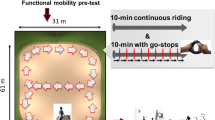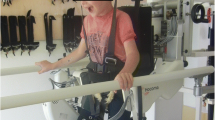Abstract
Hippotherapy, the medical use of the horse’s movement, is an evidence-based intervention option for children with cerebral palsy. The horse’s walking gait closely resembles that of a human’s normal walking pattern, providing the mounted child with multiple practice opportunities to absorb and respond to equine perturbations in three planes of movement, stimulating postural sway, postural adaptation, anticipatory feedback, and integration of multisensory information. The ability to vary the equine movement and provide multiple practice repetitions in a session provides opportunity for postural responses/adaptations that reinforce neural pathways to improve posture, strength, coordination, function, and participation. Evidence supports the incorporation of equine movement for children with cerebral palsy.
Similar content being viewed by others
References
American Hippotherapy Association, Inc. (2015) Level I Hippotherapy treatment principles course manual, 5th edn. Denver. http://www.americanhippotherapyassociation.org/about-aha/hippotherapy-magazine/
Benda W, McGibbon NH, Grant KL (2003) Improvements in muscle symmetry in children with cerebral palsy after equine-assisted therapy (hippotherapy). J Altern Complement Med 9:817–825
Bertoti DB (1988) Effect of therapeutic horseback riding on posture in children with cerebral palsy. Phys Ther 68:1505–1512
Cabiddu R et al (2016) Hippotherapy acute impact on heart rate variability non-linear dynamics in neurological disorders. Physiol Behav 15(159):88–94
Casady RL, Nichols-Larsen DS (2004) The effect of hippotherapy on ten children with cerebral palsy. Pediatr Phys Ther 16:165–172
Champagne D, Dugas C (2010) Improving gross motor function and postural control with hippotherapy in children with Down syndrome: case reports. Physiother Theory Pract 26:564–571
David KS, Sullivan M (2005) Expectations for walking speeds: standards for students in elementary schools. Pediatr Phys Ther 17(2):120–127
Encheff JL, Armstrong C, Masterson M, Fox C, Gribble P (2012) Hippotherapy effects on trunk, pelvic, and hip motion during ambulation in children with neurological impairments. Pediatr Phys Ther 24(3):242–250
Erdman EA, Willgens AM (2018) Characteristics of equine assisted therapies across the United States. In Preparation
Fleck C (1997). Hippotherapy: mechanics of human walking horseback riding. In: Engel BT (ed) Rehabilitation with the aid of the horse: a collection of studies. Durango
Garner BA, Rigby BR (2015) Human pelvis motions when walking and when riding a therapeutic horse. Hum Mov Sci 39:121–137
Ghai A, Garg N, Hooda S, Gupta T (2013) Spasticity-pathogenesis, prevention, and treatment strategies. Saudi J Anaesth 7(4):453–460
Granados AC, Agís IF (2011) Why children with special needs feel better with hippotherapy sessions: a conceptual review. J Altern Complement Med 17:191–197
Hadders-Algra M, Brogren E, Forssberg H (1998) Development of postural control-differences between ventral and dorsal muscles? Neurosci Biobehav Rev 22:501–506
Haehl V, Giuliani C, Lewis C (1999) Influence of hippotherapy on the kinematics and functional performance of two children with cerebral palsy. Pediatr Phys Ther 11:89–101
Haley S, Coster WJ, Ludlow LH, Haltiwanger JT, Andrellos PJ (1992) Pediatric evaluation of disability inventory. Trustees of Boston University, Boston
Hsie Y et al (2008) Hippotherapy on gross motor function in a child with hypotonic quadriplegic cerebral palsy: a 1-year follow up. J Phys Med Rehabil 36(3):177–185
Icanandiwill.com. Accessed on 2 June 2017 at https://www.google.com/search?q=hippotherapy+icanandiwill.com&source=lnms&tbm=isch&sa=X&ved=0ahUKEwi-z9C8xpHVAhVBOj4KHbqRCdcQ_AUIDCgD&biw=964&bih=567#imgrc=COHkjtdDPsYE6M
Jang CH, Joo MC, Hoh SE et al (2016) Effects of hippotherapy on psychosocial aspects in children with cerebral palsy and their caregivers: a pilot study. Ann Rehabil Med 40(2):230–236
Kavanagh JJ, Morrison S, Barrett RS (2005) Coordination of head and trunk accelerations during walking. Eur J Appl Physiol 94:468–475
Kwon JY, Chang HJ, Yi SH, Lee JY, Shin HY, Kim YH (2015) Effect of hippotherapy on gross motor function in children with cerebral palsy: a randomized controlled trial. J Altern Complement Med 21:15–21
Lee I, Kim J, Lee S (2011) The effects of hippotherapy on spasticity and muscular activity of children with cerebral palsy. J Korean Soc Occup Ther 19:117–124
Mackow A et al (2014) Influence of neurophysiological hippotherapy on the transference of the centre of gravity among children with cerebral palsy. Ortop Traumatol Rehabil 16(6):581–593
MacPhail HE, Edwards J, Golding J et al (1988) Trunk postural reactions in children with and without cerebral palsy during therapeutic horseback riding. Pediatr Phys Ther 10:143–147
Magee MC, Reese NB (2009) Immediate effects of a hippotherapy session on gait parameters in children with spastic cerebral palsy. Pediatr Phys Ther 21(2): 212–218
Manikowska F, Jozwiak M, Idzior M, Chen PJ, Tarnowski D (2013) The effect of a hippotherapy session on spatiotemporal parameters of gait in children with cerebral palsy-pilot study. Ortop Traumatol Rehabil 15(3): 253–257
McGibbon N, Benda W, Duncan B, Silkwood-Sherer D (2009) Immediate and long term effects of hippotherapy on symmetry of adductor muscle activity and functional ability in children with spastic cerebral palsy. Arch Phys Med Rehabil 90(6):966–974
Miller F (2005) Cerebral palsy. Springer, New York
Moreas AG (2016) The effects of hippotherapy on postural balance and functional ability in children with cerebral palsy. J Phys Ther Sci 28(8):2220–2226
Murphy D, Kahn-D’Angelo L, Gleason J (2008) The effect of hippotherapy on functional outcomes for children with disabilities: a pilot study. Pediatr Phys Ther 20(3): 264–270
Mutoh T (2016) Application of a tri-axial accelerometry-based portable motion recorder for the quantitative assessment of hippotherapy in children and adolescents with cerebral palsy. J Phys Ther Sci 28(10):2970–2974
Palisano R, Rosenbaum P, Bartlett D, Livingston M (2008) Content validity of the expanded and revised gross motor function classification system. Dev Med Child Neurol 50(10):744–750
Park ES, Rha DW, Shin JS, Kim S, Jung S (2014) Effects of hippotherapy on gross motor function and functional performance of children with cerebral palsy. Yonsei Med J 55:1736–1742
Piva SR, Teixeira PA, Almeida GJ et al (2011) Contribution of hip abductor strength to physical function in patients with total knee arthroplasty. Phys Ther 91(2): 225–233
Quest Therapeutic Services. Accessed on 2 June 2017 at https://www.questtherapeutic.com/
Reubens R, Silkwood-Sherer DJ (2016) Intervention for an adolescent with cerebral palsy during period of accelerated growth. Pediatr Phys Ther 28(1):117–125
Russell D, Rosenbaum P, Wright M, Avery LA (2013) Gross motor function measure (GMFM-66, GMFM-88). Clinics in developmental medicine, 2nd edn. Mac Keith Press, London. 290pp
SheaCenter.org. Accessed on 10 July 2017 at https://www.youtube.com/watch?v=J_MvYAvYQkk
Shore B, Spence D, Graham HK (2012) The role of hip surveillance in children with cerebral palsy. Curr Rev Musculoskelet Med 5(2):126–134
Shumway-Cook A, Woollacott M (2017) Translating theory into clinical practice, 5th edn. Wolters-Kluwer, Philadelphia
Shumway-Cook A, Hutchinson S, Kartin D, Price R, Woollacott M (2003) Effect of balance training on recovery of stability in children with cerebral palsy. Dev Med Child Neurol 45(9):591–602
Shurtleff TL, Engsberg JR (2010) Changes in trunk and head stability in children with cerebral palsy after hippotherapy: a pilot study. Phys Occup Ther Pediatr 30:150–163
Shurtleff TL, Standeven JW, Engsberg JR (2009) Changes in dynamic trunk/head stability and functional reach after hippotherapy. Arch Phys Med Rehabil 90: 1185–1195
Silkwood-Sherer DJ, Killian CB, Long TM, Martin KS (2012) Hippotherapy – an intervention to habilitate balance deficits in children with movement disorders: a clinical trial. Phys Ther 92:707–717
Sterba J, Warner M (2007) Does horseback riding therapy of therapist-directed hippotherapy rehabilitate children with cerebral palsy? Dev Med Child Neurol 49:68–73
Thelen E (1989) The (re)discovery of motor development: learning new things from an old field. Dev Psychol 25(6):946–949
TherAplay.org. Accessed on 10 July 2017 at http://childrenstheraplay.org/
Yıldırım Şık B, Çekmece C, Dursun N, Dursun E, Balıkçı E, Altunkanat Z et al (2012) Is hyppotherapy beneficial for rehabilitation of children with cerebral palsy? Türk Klin J Med Sci 32:601–608
Zadnikar M, Kastrin A (2011) Effects of hippotherapy and therapeutic horseback riding on postural control or balance in children with cerebral palsy: a meta-analysis. Dev Med Child Neurol 53:684–691
Author information
Authors and Affiliations
Corresponding author
Editor information
Editors and Affiliations
Section Editor information
Rights and permissions
Copyright information
© 2020 Springer Nature Switzerland AG
About this entry
Cite this entry
Willgens, A.M., Erdman, E.A. (2020). Using Hippotherapy Strategies for Children and Youth with Cerebral Palsy. In: Miller, F., Bachrach, S., Lennon, N., O'Neil, M.E. (eds) Cerebral Palsy. Springer, Cham. https://doi.org/10.1007/978-3-319-74558-9_163
Download citation
DOI: https://doi.org/10.1007/978-3-319-74558-9_163
Published:
Publisher Name: Springer, Cham
Print ISBN: 978-3-319-74557-2
Online ISBN: 978-3-319-74558-9
eBook Packages: MedicineReference Module Medicine




